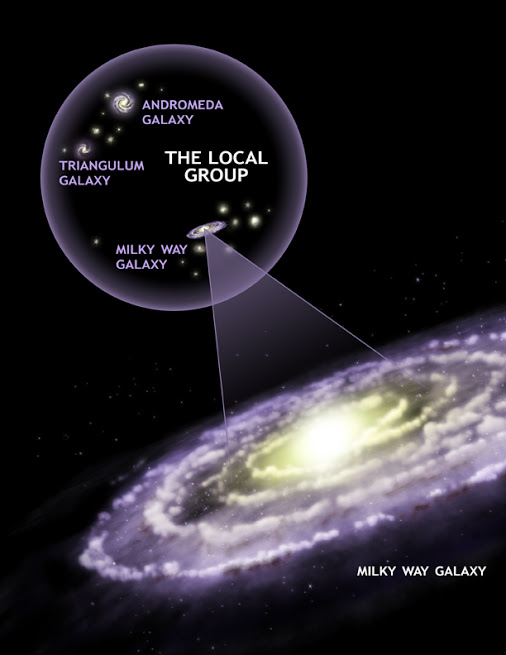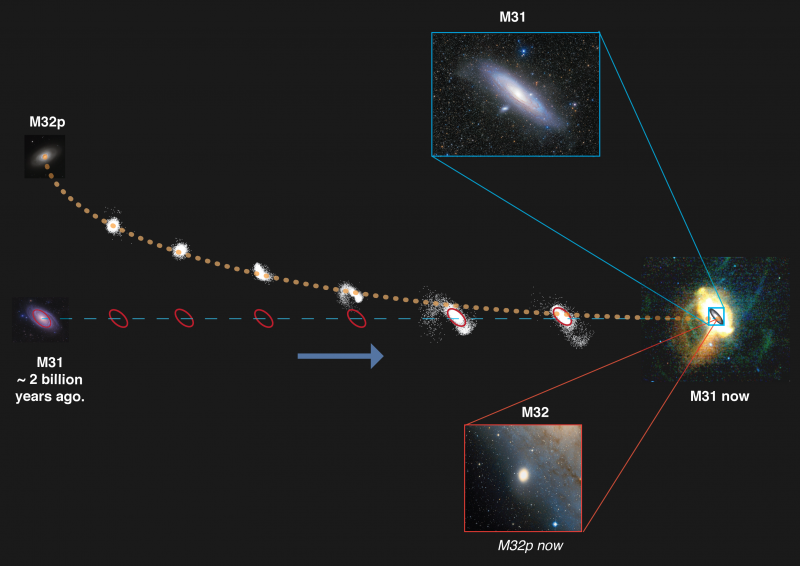

In this photo of the Andromeda galaxy, the small satellite galaxy M32 is to the left of center. This little galaxy may be all that remains of a once-massive galaxy that was canibalized by the Andromeda galaxy. Photo by Flickr user Torben Hansen.
Astronomers at the University of Michigan (U-M) announced today (July 23, 2018) that the Andromeda galaxy – closest large spiral galaxy to our Milky Way – shredded and cannibalized another massive galaxy two billion years ago. The galaxy no longer exists as the large spiral structure it once was, but a remnant of it might still exist as an Andromeda satellite, called M32. These astronomers called the progenitor galaxy a long-lost sibling to our Milky Way and the Andromeda galaxy. Its destruction left behind a rich trail of evidence, these scientists said, including M32 itself, plus an almost invisible halo of stars larger than the Andromeda galaxy. The U-M scientists said that:
Discovering and studying this decimated galaxy will help astronomers understand how disk galaxies like the Milky Way evolve and survive large mergers.
Astronomers said that – billions of years ago – the disrupted galaxy, M32p, was the third-largest member of our Local Group of galaxies. They said it started out at least 20 times bigger than any galaxy that has merged with our Milky Way over the course of its lifetime. Today, the Local Group contains two big spirals (the Milky Way and Andromeda galaxies – with a third smaller spiral called the Triangulum galaxy and dozens of much-smaller dwarf galaxies.
But once, these scientists believe, another large spiral roamed the Local Group.

Artist’s illustration of our Local Group via Chandra X-Ray Observatory.
Using computer models, astronomers Richard D’Souza and Eric Bell of the University of Michigan were able to piece together what they said is evidence for the Milky Way’s sibling. The peer-reviewed journal Nature Astronomy published their findings.
An announcement from these U-M astronomers said:
Scientists have long known that the nearly invisible large halo of stars surrounding galaxies contains the remnants of smaller cannibalized galaxies. A galaxy like Andromeda was expected to have consumed hundreds of its smaller companions. Researchers thought this would make it difficult to learn about any single one of them.
Using new computer simulations, the scientists were able to understand that even though many companion galaxies were consumed by Andromeda, most of the stars in the Andromeda’s outer faint halo were mostly contributed by shredding a single large galaxy.
Lead author D’Souza said:
It was a ‘eureka’ moment. We realized we could use this information of Andromeda’s outer stellar halo to infer the properties of the largest of these shredded galaxies.
Co-author Bell commented:
Astronomers have been studying the Local Group — the Milky Way, Andromeda and their companions — for so long. It was shocking to realize that the Milky Way had a large sibling, and we never knew about it.
They also said the formation of Andromeda’s enigmatic M32 satellite galaxy has been:
…a long-standing mystery. They suggest that the compact and dense M32 is the surviving center of the Milky Way’s long-lost sibling, like the indestructible pit of a plum.
Bell said:
M32 is a weirdo. While it looks like a compact example of an old, elliptical galaxy, it actually has lots of young stars. It’s one of the most compact galaxies in the universe. There isn’t another galaxy like it.
The astronomers said their study may alter the traditional understanding of how galaxies evolve.
Read more about this study from U-M

The process of shredding of the large galaxy M32p by the Andromeda galaxy which eventually resulted in M32 and a giant halo of stars. Image via Richard D’Souza/ Wei-Hao Wang/ AAS/ IOP/ University of Michigan.
Bottom line: Two billion years ago, the Andromeda galaxy – closest large spiral galaxy to our Milky Way – might have eaten another large galaxy. Today, the remains of that cannibalized galaxy might exist as M32, which we see as a small satellite galaxy to Andromeda.
from EarthSky https://ift.tt/2LKYQ8a


In this photo of the Andromeda galaxy, the small satellite galaxy M32 is to the left of center. This little galaxy may be all that remains of a once-massive galaxy that was canibalized by the Andromeda galaxy. Photo by Flickr user Torben Hansen.
Astronomers at the University of Michigan (U-M) announced today (July 23, 2018) that the Andromeda galaxy – closest large spiral galaxy to our Milky Way – shredded and cannibalized another massive galaxy two billion years ago. The galaxy no longer exists as the large spiral structure it once was, but a remnant of it might still exist as an Andromeda satellite, called M32. These astronomers called the progenitor galaxy a long-lost sibling to our Milky Way and the Andromeda galaxy. Its destruction left behind a rich trail of evidence, these scientists said, including M32 itself, plus an almost invisible halo of stars larger than the Andromeda galaxy. The U-M scientists said that:
Discovering and studying this decimated galaxy will help astronomers understand how disk galaxies like the Milky Way evolve and survive large mergers.
Astronomers said that – billions of years ago – the disrupted galaxy, M32p, was the third-largest member of our Local Group of galaxies. They said it started out at least 20 times bigger than any galaxy that has merged with our Milky Way over the course of its lifetime. Today, the Local Group contains two big spirals (the Milky Way and Andromeda galaxies – with a third smaller spiral called the Triangulum galaxy and dozens of much-smaller dwarf galaxies.
But once, these scientists believe, another large spiral roamed the Local Group.

Artist’s illustration of our Local Group via Chandra X-Ray Observatory.
Using computer models, astronomers Richard D’Souza and Eric Bell of the University of Michigan were able to piece together what they said is evidence for the Milky Way’s sibling. The peer-reviewed journal Nature Astronomy published their findings.
An announcement from these U-M astronomers said:
Scientists have long known that the nearly invisible large halo of stars surrounding galaxies contains the remnants of smaller cannibalized galaxies. A galaxy like Andromeda was expected to have consumed hundreds of its smaller companions. Researchers thought this would make it difficult to learn about any single one of them.
Using new computer simulations, the scientists were able to understand that even though many companion galaxies were consumed by Andromeda, most of the stars in the Andromeda’s outer faint halo were mostly contributed by shredding a single large galaxy.
Lead author D’Souza said:
It was a ‘eureka’ moment. We realized we could use this information of Andromeda’s outer stellar halo to infer the properties of the largest of these shredded galaxies.
Co-author Bell commented:
Astronomers have been studying the Local Group — the Milky Way, Andromeda and their companions — for so long. It was shocking to realize that the Milky Way had a large sibling, and we never knew about it.
They also said the formation of Andromeda’s enigmatic M32 satellite galaxy has been:
…a long-standing mystery. They suggest that the compact and dense M32 is the surviving center of the Milky Way’s long-lost sibling, like the indestructible pit of a plum.
Bell said:
M32 is a weirdo. While it looks like a compact example of an old, elliptical galaxy, it actually has lots of young stars. It’s one of the most compact galaxies in the universe. There isn’t another galaxy like it.
The astronomers said their study may alter the traditional understanding of how galaxies evolve.
Read more about this study from U-M

The process of shredding of the large galaxy M32p by the Andromeda galaxy which eventually resulted in M32 and a giant halo of stars. Image via Richard D’Souza/ Wei-Hao Wang/ AAS/ IOP/ University of Michigan.
Bottom line: Two billion years ago, the Andromeda galaxy – closest large spiral galaxy to our Milky Way – might have eaten another large galaxy. Today, the remains of that cannibalized galaxy might exist as M32, which we see as a small satellite galaxy to Andromeda.
from EarthSky https://ift.tt/2LKYQ8a

Aucun commentaire:
Enregistrer un commentaire